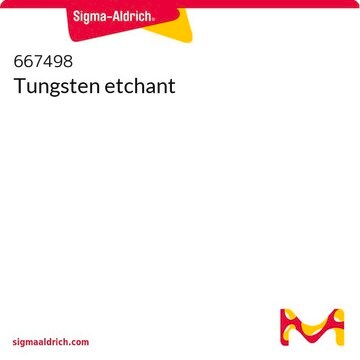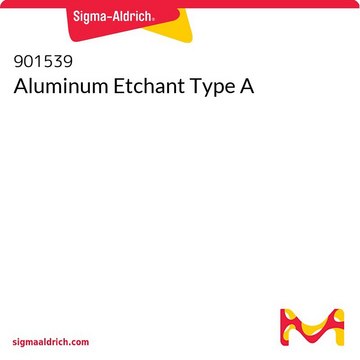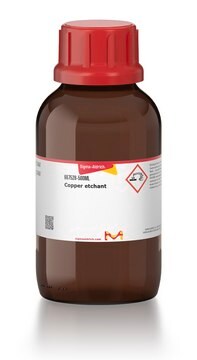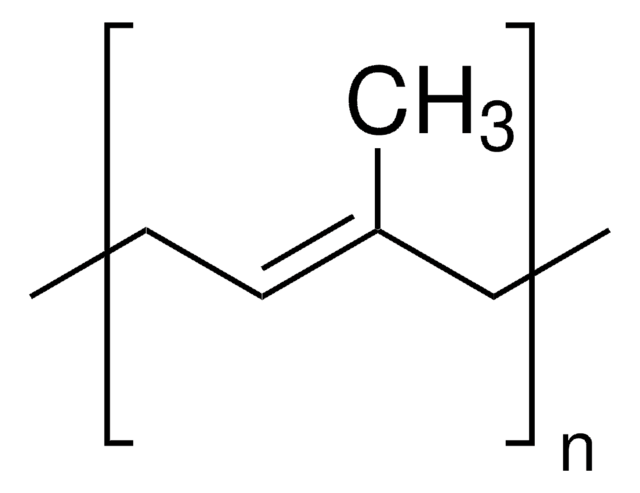Wszystkie zdjęcia(1)
Kluczowe dokumenty
About This Item
Polecane produkty
klasa czystości
standard
Poziom jakości
skład
volatiles, 85%
kolor
clear yellow-orange
bp
100 °C/1 atm
gęstość
1.16 g/mL at 25 °C
Powiązane kategorie
Opis ogólny
Nichrome etchant is a high purity etching system that is a mixture of ceric ammonium nitrate and nitric acid. It can be used to etch the nickel and chromium alloy.
Zastosowanie
Ceric ammonium nitrate-based etchant. Etches Al, Cr, Cu, Ni, GaAs. Surface oxidizes Si, Ta/TaN. Etch rate of 50 Å/sec @ 40 °C. Etches cleanly with only a deionized water rinse needed.
For use at room temperature or elevated temperature. Etches cleanly, eliminating need for an intermediate rinse.
Nichrome etchant is used in the fabrication of microheater patterns of polydimethyl siloxane (PDMS), silica (SiO2) and glass substrates, which can be further used in the fabrication of flow sensors. It may also be used to etch out nickel (Ni) from the electroplated Ni on amorphous silica wafers.
Cechy i korzyści
Designed for etching nichrome thin films used in microelectronic applications. Compatible with both positive and negative photoresists and provides fine-line control with minimal undercutting. Filtered to 0.2 micron to remove particlulates and composed of semiconductor grade materials.
Ta strona może zawierać tekst przetłumaczony maszynowo.
Hasło ostrzegawcze
Danger
Zwroty wskazujące rodzaj zagrożenia
Zwroty wskazujące środki ostrożności
Klasyfikacja zagrożeń
Aquatic Chronic 2 - Eye Dam. 1 - Met. Corr. 1 - Ox. Liq. 2 - Skin Corr. 1B - Skin Sens. 1
Zagrożenia dodatkowe
Kod klasy składowania
5.1B - Oxidizing hazardous materials
Klasa zagrożenia wodnego (WGK)
WGK 3
Temperatura zapłonu (°F)
Not applicable
Temperatura zapłonu (°C)
Not applicable
Wybierz jedną z najnowszych wersji:
Masz już ten produkt?
Dokumenty związane z niedawno zakupionymi produktami zostały zamieszczone w Bibliotece dokumentów.
Simulation and feasibility study of flow sensor on flexible polymer for healthcare application.
Maji D and Das S
IEEE Transactions on Bio-Medical Engineering, 60(12), 3298-3305 (2013)
Perfectly plastic flow in silica glass.
Kermouche G, et al.
Acta Materialia, 114(12), 146-153 (2016)
Protokoły
Negative Photoresist Procedure
Global Trade Item Number
| SKU | GTIN |
|---|---|
| 651834-500ML | 4061838147950 |
Nasz zespół naukowców ma doświadczenie we wszystkich obszarach badań, w tym w naukach przyrodniczych, materiałoznawstwie, syntezie chemicznej, chromatografii, analityce i wielu innych dziedzinach.
Skontaktuj się z zespołem ds. pomocy technicznej












